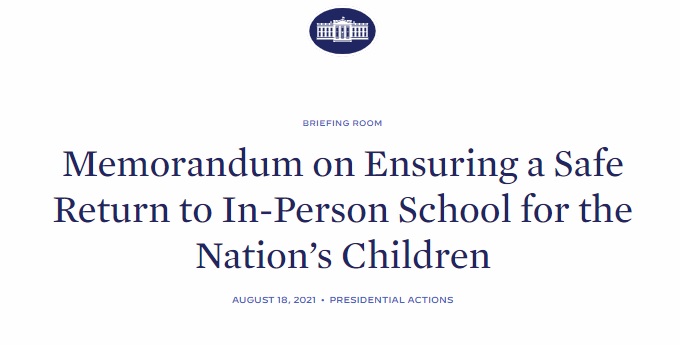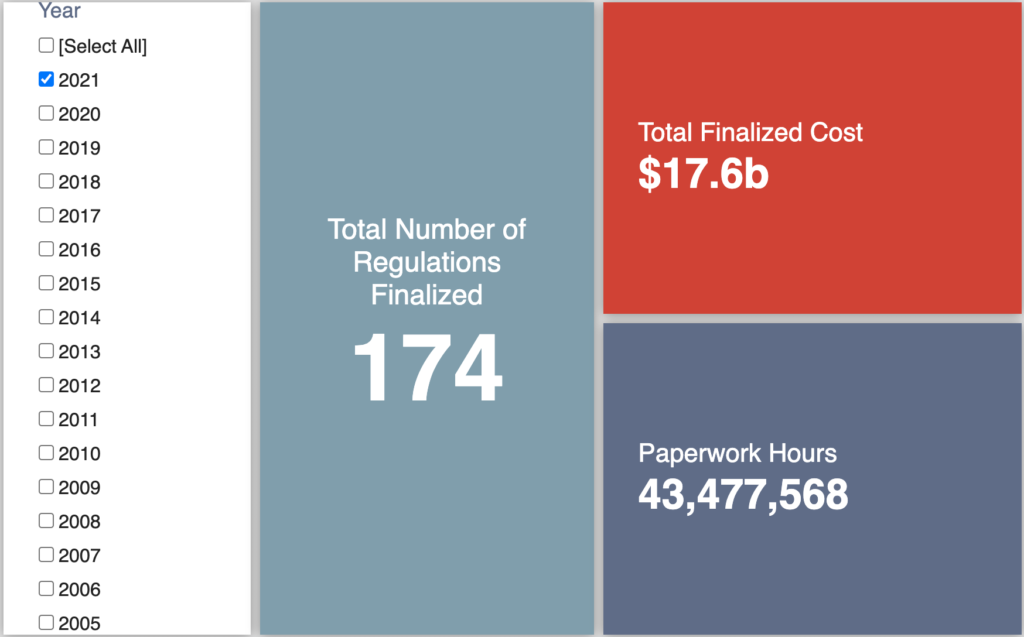Week in Regulation
August 23, 2021
Another Big Proposed Rule Drops
Like last week, this week’s highest-profile action in the Federal Register was a proposed rule. While last week’s vehicle emissions rule was the most expensive proposed rule the American Action Forum (AAF) has ever tracked, this week’s most-notable proposed rule slots in as the second-costliest proposal of the Biden Administration. Across all rulemakings, agencies published $3.4 billion in total net costs and added 12.1 million paperwork burden hours.
REGULATORY TOPLINES
- Proposed Rules: 28
- Final Rules: 58
- 2021 Total Pages: 46,873
- 2021 Final Rule Costs: $17.6 billion
- 2021 Proposed Rule Costs: $138.3 billion
NOTABLE REGULATORY ACTIONS
Another week, another big proposed rule: The Departments of Homeland Security and Justice (Departments) proposed amendments to regulations governing the processing of asylum claims that they believe will “increase both the efficiency and the procedural fairness of the expedited removal process for individuals who have been found to have a credible fear of persecution or torture.” The proposed rule would also undo many of the changes made to the asylum process during the Trump Administration. The Departments estimate the total costs of the rule at $3.2 billion and an annual paperwork burden of more than 11 million hours.
The Federal Communications Commission (FCC) proposed a rule that would prohibit certain communications equipment from companies on the “Covered List,” i.e., those determined to be national security threats. This list includes companies such as Huawei and ZTE Corporation. The FCC estimates about $150 million in paperwork costs over three years should the rule go final.
This week’s final rules were a different story. Federal agencies combined to publish just five such rules with estimated costs. The largest one was a routine airworthiness directive from the Federal Aviation Administration with $10.8 million in total costs.
TRACKING THE ADMINISTRATIONS
As we have already seen from executive orders and memos, the Biden Administration will surely provide plenty of contrasts with the Trump Administration on the regulatory front. And while there is a general expectation that the new administration will seek to broadly restore Obama-esque regulatory actions, there will also be areas where it charts its own course. Since the AAF RegRodeo data extend back to 2005, it is possible to provide weekly updates on how the top-level trends of President Biden’s regulatory record track with those of his two most recent predecessors. The following table provides the cumulative totals of final rules containing some quantified economic impact from each administration through this point in their respective terms.
A quiet week for final rules from the Biden Administration mirrored similar weeks for the Trump and Obama Administrations, although the nearly $20 million in added costs this week is more than double either of the previous regimes. The most notable changes from the previous administrations were in paperwork, where the Obama Administration added 293,000 hours while the Trump Administration trimmed 90,000.
THIS WEEK’S REGULATORY PICTURE
This week, President Biden directs the Department of Education (ED) to use its authority to stop states and municipalities from implementing certain policies affecting COVID-19 protocols in schools.
On August 18, President Biden issued a “Memorandum on Ensuring a Safe Return to In-Person School for the Nation’s Children.” The action was aimed at using the authority of the federal government to prevent some local governments from penalizing schools that choose to abide by federally recommended COVID-19 safeguards, such as requiring mask-wearing in classrooms.
The impetus for the memorandum was recent policies adopted by states – namely Florida and Texas – that prohibit schools from certain measures, including requiring masks, contact tracing, and mandatory vaccinations. The memorandum specifically cites “some State governments” that have “adopted policies and laws that interfere with the ability of schools and districts to keep our children safe during in-person learning.”
The memorandum directs the Secretary of Education to ensure that governors and other officials are not preventing schools from implementing measures recommended by the Centers for Disease Control and Prevention or interfering with the ability of students to safely participate in in-person schooling.
If ED determines a government or official is doing either, the memorandum directs ED to consider initiating enforcement actions under applicable laws.
The memorandum likely ensures the ongoing legal controversy about state prevention or adoption of certain COVID-19 mandates will continue well into the autumn.
TOTAL BURDENS
Since January 1, the federal government has published $155.9 billion in total net costs (with $17.6 billion in new costs from finalized rules) and 44.9 million hours of net annual paperwork burden increases (with 43.5 million hours in increases from final rules).












